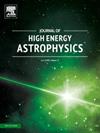Cosmological phase-space analysis of f(G)-theories of gravity
IF 10.5
4区 物理与天体物理
Q1 ASTRONOMY & ASTROPHYSICS
引用次数: 0
Abstract
The impact of topological terms that modify the Hilbert-Einstein action is here explored by virtue of a further contribution. In particular, we investigate the phase-space stability and critical points of an equivalent scalar field representation that makes use of a massive field, whose potential is function of the topological correction. To do so, we introduce to the gravitational Action Integral a Lagrange multiplier and model the modified Friedmann equations by virtue of new non-dimensional variables. We single out dimensionless variables that permit a priori the Hubble rate change of sign, enabling regions in which the Hubble parameter either vanishes or becomes negative. In this respect, we thus analyze the various possibilities associated with a universe characterized by such topological contributions and find the attractors, saddle points and regions of stability, in general. The overall analysis is carried out considering the exponential potential first and then shifting to more complicated cases, where the underlying variables do not simplify. We compute the eigenvalues of our coupled differential equations and, accordingly, the stability of the system, in both a spatially-flat and non-flat universe. Quite remarkably, regardless of the spatial curvature, we show that a stable de Sitter-like phase that can model current time appears only a small fraction of the entire phase-space, suggesting that the model under exam is unlikely in describing the whole universe dynamics, i.e., the topological terms appear disfavored in framing the entire evolution of the universe.
重力理论f(G)的宇宙相空间分析
通过进一步的f(G)贡献,本文探讨了改变希尔伯特-爱因斯坦作用的拓扑项的影响。特别地,我们研究了利用大质量场的等效标量场表示的相空间稳定性和临界点,其势是拓扑校正的函数。为此,我们在引力作用积分中引入拉格朗日乘子,并利用新的无量纲变量对修正后的弗里德曼方程进行建模。我们挑选出无量纲变量,这些变量允许先验的哈勃速率符号变化,使哈勃参数消失或变为负值的区域成为可能。在这方面,我们因此分析了以这种拓扑贡献为特征的宇宙的各种可能性,并找到了一般的吸引子、鞍点和稳定区域。总体分析首先考虑指数势,然后转移到更复杂的情况下,其中潜在的变量不简化。我们计算了耦合微分方程的特征值,并相应地计算了系统在空间平坦和非平坦宇宙中的稳定性。值得注意的是,无论空间曲率如何,我们都表明可以模拟当前时间的稳定的德西特相只出现在整个相空间的一小部分,这表明所测试的模型不太可能描述整个宇宙的动力学,即拓扑项在构建宇宙的整个演化过程中似乎不受欢迎。
本文章由计算机程序翻译,如有差异,请以英文原文为准。
求助全文
约1分钟内获得全文
求助全文
来源期刊

Journal of High Energy Astrophysics
Earth and Planetary Sciences-Space and Planetary Science
CiteScore
9.70
自引率
5.30%
发文量
38
审稿时长
65 days
期刊介绍:
The journal welcomes manuscripts on theoretical models, simulations, and observations of highly energetic astrophysical objects both in our Galaxy and beyond. Among those, black holes at all scales, neutron stars, pulsars and their nebula, binaries, novae and supernovae, their remnants, active galaxies, and clusters are just a few examples. The journal will consider research across the whole electromagnetic spectrum, as well as research using various messengers, such as gravitational waves or neutrinos. Effects of high-energy phenomena on cosmology and star-formation, results from dedicated surveys expanding the knowledge of extreme environments, and astrophysical implications of dark matter are also welcomed topics.
 求助内容:
求助内容: 应助结果提醒方式:
应助结果提醒方式:


